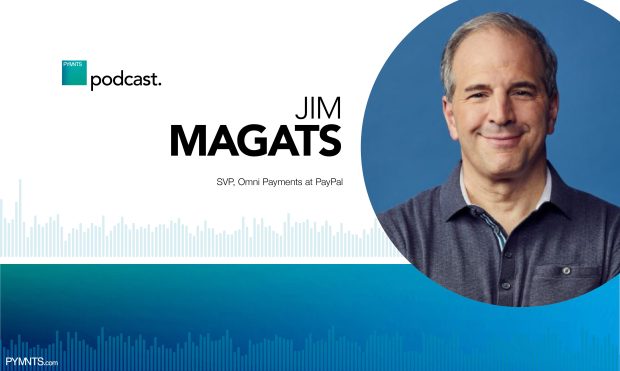PayPal’s Jim Magats: SMBs Must Meet Customers Across Connected Economy’s ‘Four Domains’

In the connected economy, consumers want to simplify how they access the many things that were once resident in individual apps on their phones. The far-flung data that is created as consumers research, browse and transact — in essence the information that follows them around across channels — creates an ecosystem in which consumers and businesses come together to get things done, PayPal‘s SVP of Omni Payments Jim Magats told Karen Webster.
“Data ultimately exists as the lifeblood of the connected economy,” he said. “It is in essence what creates the ability for all this connectivity to come to fruition.”
And data in the service of protecting consumers and businesses against fraud and risk can help merchants and issuers boost transaction approval rates — which is the cornerstone of creating an efficient, connected economy experience.
As he added, any business — large or small — needs to know who their end customer is. But that’s easier said than done, noted Magats, and it’s especially onerous for smaller companies.
The smaller firm — the hypothetical 10-person enterprise with less than $5 million in sales — must constantly fine-tune what they want to sell, to whom and how much inventory to have on hand.
For those firms, for all merchants, he said, digital is a euphemism for connectedness, but the smaller players are scrambling to catch up to larger merchants with deeper pockets, and, perhaps, first-mover advantage.
“You’re starting to sell through eBay, and across stores. Some of these different places, well, it’s a real challenge to effectively orchestrate your commerce across all those different areas,” he said of those small and medium-sized businesses (SMBs). Opening up a digital storefront, in addition to having a physical one, adds cost and time to the equation in the quest to create an omnichannel experience.
See also: Linktree, PayPal Team To Provide Commerce Links For Social Media Creators
We’re still in the early innings of creating the data collection and parsing activities — the measurements of loyalty and other metrics — that help companies know who, as a personality, is on the other side of the transaction, building context and customization at the point of engagement.
If firms don’t make the omnichannel leap, they risk consumer loyalty. Said Magats: “The separation between those merchants that can do it, and those that can’t, will become extremely stark.”
The Four Domains
No matter their size, merchants are effectively selling across four domains: the physical environment, the online storefront, different social media platforms like Instagram — and, as Magats noted, “you’re likely selling across marketplaces, too.”
And, as he continued, the data that follows and surrounds a customer as he or she shows up on a social media site, or when they walk through a retailer’s brick-and-mortar location can be used to create what might be likened to a federated identity — and can enable a plethora of use cases.
“The degree to which we know who you are, and all those different places, creates the kernel of a unique identifier to make sure that you [as a merchant] do know it’s me.” That knowledge, he said, helps merchants craft consistent experiences, yes, but also connected ones. Familiarity between a merchant and consumer leads, ultimately, he said, to higher approval rates and conversions.
An illustration of how that familiarity and connected commerce go hand in hand, he said is that merchants can craft personalized offers or engagement across a consumer’s preferred channel(s).
The challenge, of course, comes as there are “28 different dimensions of complexity” with which merchants must grapple, across a product/service lifecycle, from order-management systems to payments to inventory management to marketing.
Things get especially rough for those aforementioned smaller merchants, said Magats, as they might find it a herculean task to manage a single catalog of offerings across sites tangible and digital.
“They want to create more customization,” he said, “they want to know its ‘Jim who likes blue shirts’ coming onto the website, or similarly, if Jim is on Instagram or looking up blue shirts — do the merchants have that data that can be then fed back when Jim shows up on the website? The smaller you are, the more complicated is to create that unified experience.”
He noted that PayPal’s historical dataset, along with its in-place payments infrastructure tied to 32 million merchants, gives the firm a conduit to connecting those four shopping domains in an ecosystem bound together with payments as the glue.
Looking ahead, he said, the connected experience is where the consumer wants to be, so merchants are going to have to strive, quickly, to get there. As he told Webster, “The merchants have to manage across these four different domains simultaneously. The key is to make the inventory and the process consistent and seamless, no matter the channel. Don’t try to go against the tide of where your customers are.”
You may also like: PayPal Zettle US Launch Brings ‘Commerce In Box’ To SMBs
